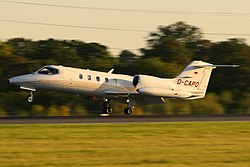The aircraft involved, registration N388LS, was operated by the Aircraft Charter Group and flown by pilots Johan Schwartz and Patrick Hayes for a repositioning flight to Lebanon, New Hampshire. They left Sikorsky Memorial Airport in Bridgeport, Connecticut at 09:19 am, and 25 minutes later were flying the approach into Lebanon Municipal Airport. After one attempt at the instrument landing system approach, the crew reported that they were unable to receive the localizer, when they were actually several miles off course. They presumed ground equipment failure, and the pilot told the tower that he was executing a missed approach. The aircraft's last radar contact was as it proceeded outbound, 7 nautical miles (13 km) northeast of the VOR, at 4,800 ft (1,500 m). [3] As the business jet neared the inbound course to the VOR, the captain called out the outer marker. The first officer agreed, and the captain stated that they could descend to 2,300 ft. Shortly thereafter, the first officer stated that he was descending the aircraft to 2,300 ft. Three seconds later, the Learjet impacted trees, then terrain. The wreckage was located at an altitude of 2,300 ft, on rising mountainous terrain, 061° magnetic, 12.5 nautical miles from the VOR. The weather conditions were raining and foggy at the time.
Searches were mounted, unsuccessfully. The wreckage was found near Smarts Mountain almost three years later, on November 13, 1999, about 20 mi (32 km) from the airport. Debris was spread over a 150-yard (140 m) area in dense forest. The aircraft had descended into the ground 10.3 nmi (19.1 km) earlier than normal.
The cause of the accident, as determined by the National Transportation Safety Board, was:
The captain's failure to maintain situational awareness, which resulted in the airplane being outside the confines of the instrument approach; and the crew's misinterpretation of a step-down fix passage, which resulted in an early descent into rising terrain. Factors included the captain's misreading of the instrument approach procedure, the crew's rushed and incomplete instrument approach briefing, their failure to use additional, available navigational aids, and their failure to account for the winds at altitude. [4]
This page is based on this
Wikipedia article Text is available under the
CC BY-SA 4.0 license; additional terms may apply.
Images, videos and audio are available under their respective licenses.
